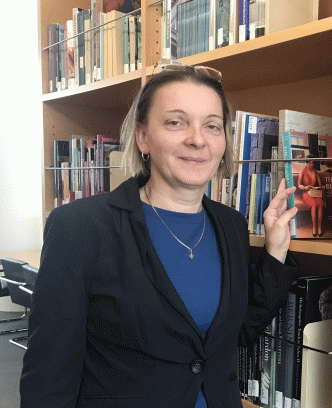Prof. Dr. Barbara Kristina Murovec
Visiting Scholar

Barbara Kristina Murovec, Visiting Scholar at the Kunsthistorisches Institut in Florenz – Max-Planck-Institut, studied art history and comparative literature in Ljubljana, Munich, Vienna and Graz, obtained her PhD in Ljubljana in 2000 and her habilitation in Maribor in 2009, where she taught from 2010 to 2019. From 2005 to 2018 she was director of the France Stele Institute for Art History of the Research Centre of the Slovenian Academy of Sciences and Arts, and from 2010 to 2016 she served as Secretary and Second Vice-President of RIHA (International Association of Research Institutes in the History of Art). Most recently she was a guest scholar at the Getty Research Institute in Los Angeles and at the Zentralinstitut für Kunstgeschichte in Munich. She coordinated several national and international projects; the monograph of the EU HERA project (2016 to 2020) Transfer of Cultural Objects in the Alpe Adria Region in the 20th Century (TransCultAA) will be published by Böhlau in autumn 2021 (ed. together with Christian Fuhrmeister).
- Art History
- Painting and graphic arts from the 16th to the 18th century (especially Baroque ceiling painting)
- Sculpture from the 19th to the 20th century (Habsburg Monarchy, Yugoslavia)
- Collecting and patronage studies
- Provenance research
- Iconography and iconology
- City/monument/cultural heritage and memory studies
- Art (history) and politics, ethics, identity, emotions and (war) trauma
- Historiography and methodology of art history
Ignaz Maria Count Attems (1652–1732) as a patron of Baroque ceiling painting
Book project: Count Ignaz Maria Attems, a member of an ancient noble family from Friuli with the ancestral castle seat of Attimis, was born in 1652 in Laibach (today Ljubljana in Slovenia) as the youngest son of the governor of the Duchy of Carniola, Johann Ferdinand Attems-Heiligenkreuz, and his third wife Francesca Markiza Strozzi from Mantua. Attems' ambition was to emphasize his own importance and representation through art collecting, and this probably led him to express his achievements in restoring peace in the country, his arts patronage and his social advancement in his new home Styria, by means of architecture, but above all by commissioning ceiling paintings. His ambition however did not coincide with the requisite financial means (at least initially). In Lower Styria, near the Croatian-Slavonian military border, he bought and renovated castles and built new manor houses to ensure the appropriate representation of his family. Festive halls, staircases and chapels of his castles were extensively decorated with frescoes. In the period of peace that began around 1700, Attems secured his social advancement as one of the most important patrons of the arts in the region and had his generosity (Liberalitas) towards artists visualised in detail in ceiling paintings. In order to approach the concept of 'historia' presumably intended by Ignaz Maria Count Attems in his profane and sacred commissions, the research project will use a combined methodology, including in particular the systematic investigation and connection of his biography with the historical context as well as comparative iconographic research and analysis of the (graphic) models used.
“Materiality” of the Visual Knowledge of Travelling Patrons
The project is dedicated to the Grand Tours (Kavalierstouren) and other journeys of (future) patrons in the Early Modern period and to the knowledge transfer and cultural import shaped by them. In which way the collection of impressions, memories and observations of the visited cities, places, buildings, ceiling paintings and art objects as well as the “papers” (illustrated books, drawings, prints, etc.) brought back from the journeys acted as “ideas” and models for the complex concepts for the new commissions at home will be researched in the project.


